AUTONEWS

Travelers split on whether they would take trips in autonomous vehicles, study finds
Autonomous vehicles are becoming more of a reality as technology improves, but people are far from settled in accepting a future with driverless cars. A University of Kansas researcher has co-written a study that found when asked if they would make a trip they had recently completed in an autonomous vehicle, respondents fell into roughly equal camps of enthusiastic acceptance, resistance or uncertainty. The findings show there is more uncertainty about adopting the technology than expected.
One key question about connected and autonomous vehicles, or CAVs, and how they would be used focuses on ownership, such as whether individuals would possess their vehicles or access them as part of a service similar to rideshare programs. CAVs have potential benefits such as pollution reduction, enhanced accessibility and reduced congestion via more efficient vehicle travel, but those benefits are irrelevant if people are unwilling to use such vehicles. And whether people are willing to use them is influenced by ownership models, among other factors, the study found.
Researchers conducted an intercept survey asking travelers who had just completed a trip to one of four leisure or social sites in Ann Arbor, Michigan, if they would make the same trip in a CAV. Ann Arbor was chosen as a moderately sized city that is well-informed about CAVs because of its proximity to the University of Michigan, which has been largely involved in testing new vehicle technologies.
"There was a clear delineation in the responses," said Bradley Lane, associate professor of public affairs & administration at KU and a co-author of the study. "About one-third said, 'Hell yes,' and one-third said, 'Hell no' in a pretty well-informed community. Even in the group likely to adopt, there was still uncertainty."
The study, published in the journal Sustainability, was co-written by Scott Kelly of the University of Nevada-Reno and John DeCicco of the University of Michigan Energy Institute.
Researchers also asked respondents if owning the vehicle themselves or accessing it as part of a service would make a difference. Researchers also collected demographic information on participants to gauge how that corresponded with their responses. Of the four trip locations, two were in high-density areas with good public transit and walkable access, and two were in more suburban locales. Researchers chose social locations as studies have shown people tend to use rideshare services for social or recreational trips as opposed to commuting and to reflect that possibility when considering CAVs.
"When you look at services like Uber and Lyft now and how they're used, it is primarily for discretionary trips, largely so you don't have to drive home, especially in parts of the country highly dependent on driving," Lane said.
Among those surveyed, 36 percent said they would take the same trip they had just made in a CAV regardless of whether they owned it or it was part of a service. Thirty-one percent said they would consider not taking the trip, and the remaining third was split. About 5 percent were neutral, while the remainder was divided among people who said they would consider only one type of ownership over the other.
Personal characteristics of the respondents largely predicted willingness to use CAVs and which type they would consider.
"Where we found differences in their adoption intention was if they were under 35 or lived near a bus stop, they were more likely to share. If they lived in a wealthy area or more than two and a half miles from the location, they assumed they'd own the CAV," Lane said. "People who didn't own a car were more likely to take either. That was clearly seen as being able to boost mobility."
Travelers who drove alone were more interested in trying either form of CAVs. Additional factors included whether the trip took place after 4:00 p.m., if travelers had considered rideshare in the past and if they lived farther from their destination. Those who took a bus were more likely to use a service or didn't expect that they'd own a CAV. Those who had walked or rode a bicycle to the survey locations held to those as their main mode of transport and said they would be more likely to use a service.
The variations in the findings show that it is far too early to assume CAVs will be widely adopted, even in areas where such vehicles would seem most likely to be a natural fit, Lane said. They also illustrate that more research is needed before CAVs become more common and to help inform policy regarding autonomous vehicles, action states are increasingly taking. Lane said he hopes to conduct similar studies in other cities and regions to see how results would compare. For now, individual characteristics tell more about whether a person would be willing to adopt driverless technology.
"The biggest thing that stood out is if you had used shared mobility in the past, you were more likely to consider autonomous vehicles," Lane said. "You were also more likely to adopt if under 35. It's classic early adopter profiles screaming at you."
by Mike Krings, University of Kansas

Nenhum comentário:
Postar um comentário